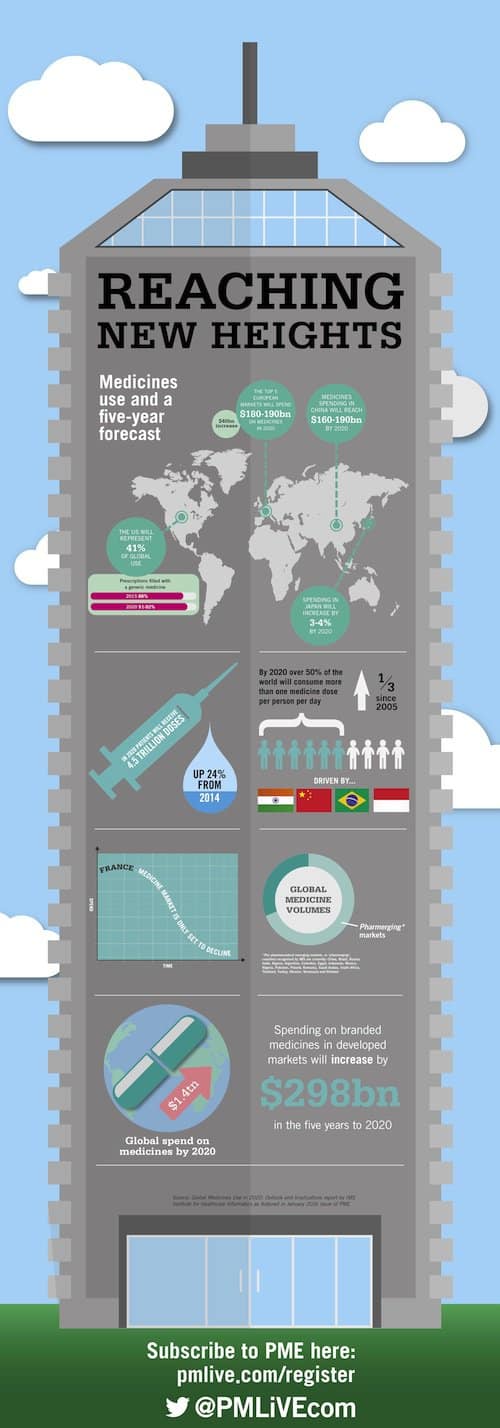
In our recent report, Global Medicines Use in 2020: Outlook and Implications, the IMS Institute for Healthcare Informatics examined three key aspects of the use of medicines globally in five years’ time. The aspects were: patterns of use on a volume basis; distribution and trends in spending and the impact of transformative innovations on patient care.
Volume basis trends
The volume of medicines used globally will reach 4.5 trillion doses by 2020 and cost $1.4tn, both representing significant increases from 2015. The largest pharmaceutical-using countries will be the ‘pharmerging’ markets, with two-thirds of the global medicine volumes, mostly comprised of generic medicines and dramatic increases in the utilisation of medicines due to broad-based health system expansions. Developed markets will continue to account for the majority of medicine spending due both to higher prices per unit and the mix of newer medicines that bring meaningful clinical benefit to patients facing a wide range of diseases.
In 2020, more of the world’s population will have access to medicine than ever before, albeit with substantial disparities. Patients will receive 4.5 trillion doses, up 24% from 2015, with most of the increase from countries closing the gap in per capita usage of medicines between developed and ‘pharmerging’ countries. Over 50% of the world’s population will consume more than one dose per person per day of medicines, up from one-third of the world in 2005, driven by India, China, Brazil and Indonesia. Developed markets will continue to use more original branded and specialty medicines per capita while ‘pharmerging’ markets will use more non-original brands, generics and over the counter medicines.
Spending and distribution trends
Global spending on medicines will reach $1.4tn by 2020, an increase of $349bn from 2015, a slightly smaller increase in relative terms compared to the prior five years. Spending growth will be driven by brands in developed markets and increased usage in ‘pharmerging’ markets, while being offset by patent expiries. Brand spending in developed markets will increase by $298bn in the five years to 2020 driven by new products and price increases primarily in the US, but will be offset by an estimated $90bn in net price reductions. Small molecule patent expiries will have a larger impact in 2016-2020 than in the prior five years, and there will be an increased impact from biologics. In 2020, the US, EU5 and Japan will have important differences in spending and growth dynamics from today. ‘Pharmerging’ markets’ spending will grow primarily from increased use of medicines while China, the leading ‘pharmerging’ country, will reach $160-190bn in spending with slowing growth to 2020.
The US will represent 41% of global medicine spending in 2020 but generic medicines will continue to provide the vast majority of the prescription drug usage in the US, rising from 88% to 91-92% of all prescriptions dispensed by 2020. While invoice price growth – which does not reflect discounts and rebates received by payers – is expected to continue at historic levels during the next five years, net price trends for protected brands will remain constrained by payers and competition, resulting in 5-7% annual price increases. The impact of the Affordable Care Act (ACA) will continue to have an effect on medicine spending during the next five years largely due to expanded insurance coverage.
The Top 5 European markets will spend $180-190bn on medicines in 2020, an increase of $40bn, which includes $19.4bn of exchange rate effects and is mostly driven by Germany and the wider adoption of specialty medicines. Other major European countries will face budget challenges and France, alone among developed markets, will see a decline in the volume of medicines used on a per capita basis.
Japan’s growth is expected to return to historic patterns through 2020 and the long-term effects of the new price regime will see average prices at a market level remain essentially unchanged from 2015. Spending will increase by 3-4% over the next five years, the lowest aggregate increase of any developed market, but a very robust and positive dynamic for newer brands.
Growth in spending on medicines in ‘pharmerging’ markets of $125bn to 2020 is driven primarily by wider use of medicines. The per capita increases in volume and spending reflect the strong commitment to wider access to healthcare from government and expanded private insurance markets that many ‘pharmerging’ countries are experiencing. While spending and growth are primarily driven by lower cost generics and locally produced medicines, important opportunities remain for multinational companies in bringing their new medicines to emerging markets.
By 2020, technology will be enabling more rapid changes to treatment protocols
Transformative medicine use
The overwhelming inertia in medicine use – where 97% of medicines used have been available for more than ten years – masks the contribution from transformative disease treatments, orphan drugs for rare diseases and technology-enabled changes in care that can harness big data to better inform decisions, help drive patient behaviour changes and improve outcomes. The seemingly intractable problems of neglected tropical diseases, compounded by poverty and war in Africa, finally appear to be responding to philanthropy-funded research and engagement, resulting in fundamental changes by 2020.
The use of medicines in 2020 will include 943 New Active Substances introduced in the prior 25 years, and new medicines in recent years will be weighted to specialty and biologics. Patients will have greater access to breakthrough therapies and clusters of innovation around a variety of common and rare diseases.
More than 225 medicines will be introduced by 2020, with one-third focused on treating cancer. Disease treatments in 2020 will be transformed by the increased number and quality of new drugs in clusters of innovation around cancer, hepatitis C, autoimmune disorders, heart disease and an array of rare diseases.
By 2020, technology will be enabling more rapid changes to treatment protocols, increasing patient engagement and accountability. All patients with multiple chronic conditions will have the potential to use wearables, mobile apps and other technologies to manage their health and interact with providers, fellow patients and family members.
Implications
The continued expansion of healthcare access around the world portends a fundamental gap in delivery capacity where added patient access outruns staffing, infrastructure and funding sources. By 2020 we will see a substantial shift in many major markets away from the siloed budgeting that manages drug spending separately from other healthcare costs. Emerging economies will be focused on providing access and essential medicines to those in need to close endemic healthcare gaps. Providers in more parts of the world will be subject to performance or outcomes-based contracts and payment systems, bringing sharper scrutiny to patient outcomes and costs associated with patient care.
More healthcare will be delivered using technology-enabled means, by providers other than doctors and in patients’ homes, pharmacies and community-based facilities. The use of technology will be key to the advancement of healthcare, especially in emerging markets where the expense of large scale infrastructure projects would delay progress.
In low and middle income countries direct out-of-pocket cash payments will shift to premiums for private or supplementary insurance as countries strive for universal health coverage.
The outlook to 2020 includes higher levels of medicine spending and therefore higher revenues for manufacturers than in the last five years. The extent and nature of the issues faced by healthcare stakeholders and the sources of the spending growth projected in this report belie a more complex challenge to the sustainability of the pharmaceutical industry. Critical adaptations will be necessary to thrive into the next decade, and key among them will be listening and providing valuable solutions to the problems their customers face.
- Full-size version of PMLiVE’s Reaching new heights infographic






